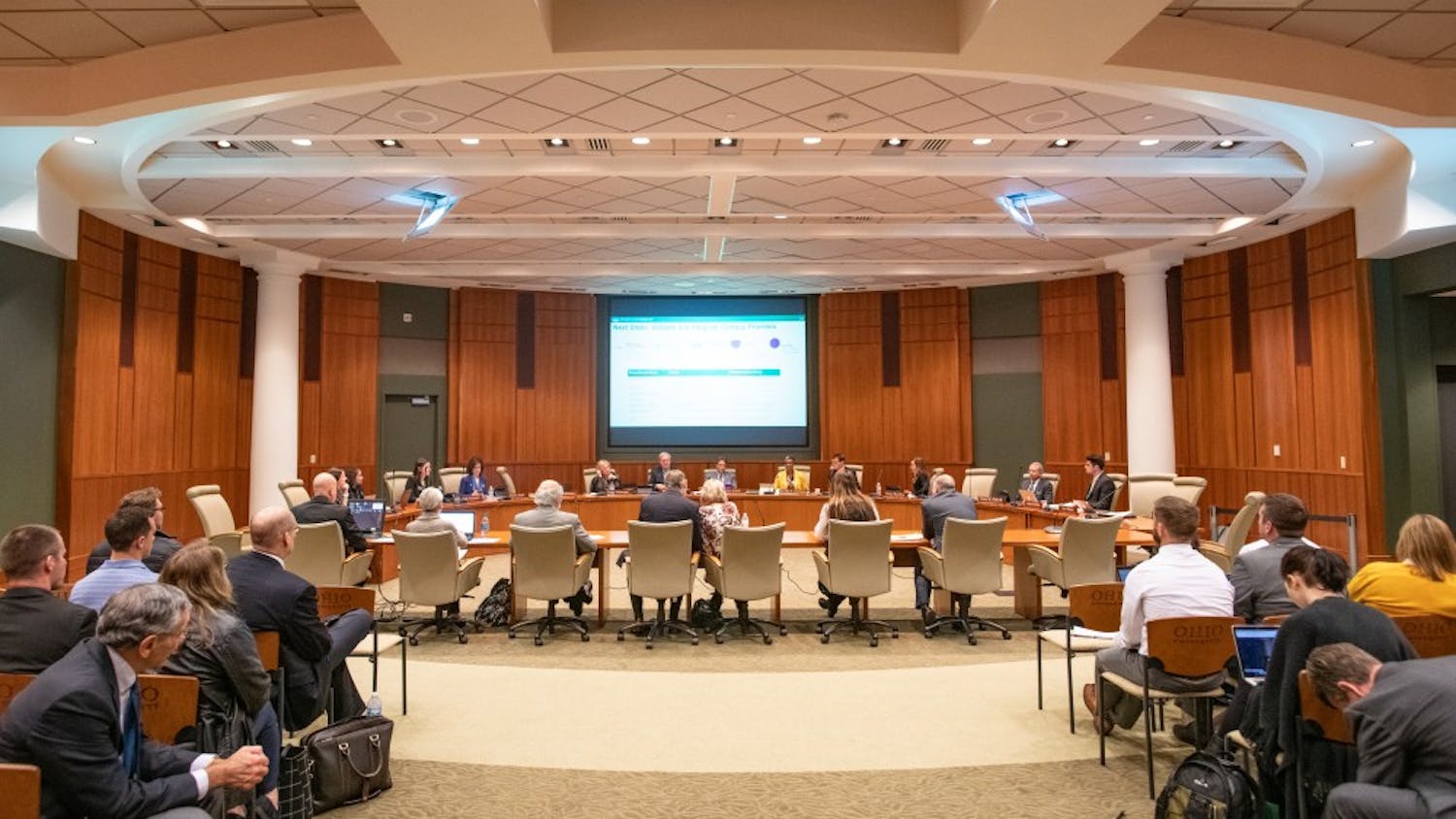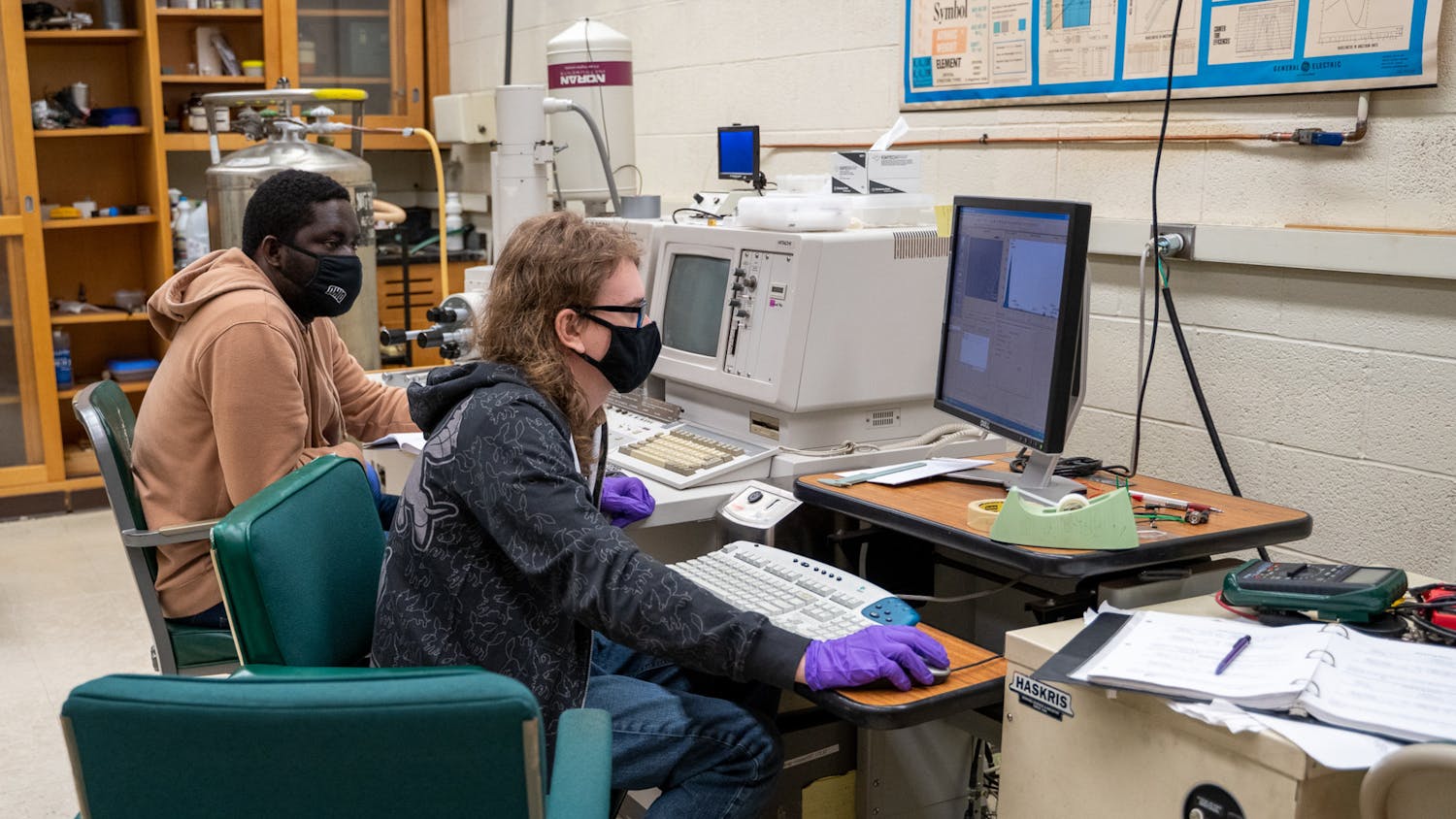The Ohio University Board of Trustees met Thursday and Friday to discuss the university’s R1 status, capital projects and a reflection from President Hugh Sherman.
Main Board Meeting
Sarah Wyatt, director of molecular and cellular biology, started the Main Board Meeting with information about the difference in advising levels in schools, the loss of faculty and Student Senate’s continuous work.
Following Wyatt's speech, two pages worth of resolutions were announced and passed.
The resolutions included an increase to undergraduate tuition that will depend on what the state government sets its cap for tuition, room and board fees and rates, approval of the FY24 century bond allocation, the capital improvement plan resolution, the capital projects resolution, the secretary of the board resolution, and the approval of the consent agenda.
OU’s President Sherman gave his farewell report on three topics; the Ohio experience, our impact on communities, and students.
After his report, President Sherman invited the newly appointed OU President, Lori Stewart Gonzalez to come up to the stand where she was greeted with her own official name tag.
President Gonzalez addressed her appreciation for such a warm welcome from everyone at OU and gave some insights on her goals for her first year.
“We have to continue to work as a team, with the board and administration, the faculty and staff to support our students,” President Gonzalez said. “Education is our core mission.”
Academics and Student Success Committees
Interim Vice President for Research David Koonce informed the board that the university's research and graduate education influenced how OU was named a “Research 1” institution by the Carnegie Classification of Institutions of Higher Education.
In January 2022, OU, alongside 141 other institutions, was named with the highest level of research recognition under the Carnegie classification, according to a previous Post report.
Currently, all schools within the U.S. are arranged on Carnegie Classification to be better represented, Koonce said. To categorize schools, Carnegie looks at a university’s expenditures, doctoral productions, non-faculty researchers and tenure track faculty, he said.
Ultimately, Koonce said, OU reached a very high research status due to a “comprehensive campus approach” of doctoral students and research. The university is producing many doctorate students not only from STEM disciplines but also from humanities departments, he said.
“The key to that is we did not intentionally try to move into R1 through strategic investments in areas to maximize. We organically grew,” Koonce said. “We invested in the areas that we wanted to see OU grow in and they aligned with what Carnegie saw as a research school.”
Even with OU’s keen doctoral production, there are still areas that need to be improved. Koonce said doctorate programs need to better account for their research, which includes fully capturing research expenditures, retaining high productivity and quality faculty and supporting doctoral students.
However, Koonce notified the board that later this year, Carnegie will release information about modifying criteria classification, which will be implemented starting in 2024. He said he will note these changes to understand how they will affect OU and its future rankings.
The board also heard from Executive Vice President and Provost Elizabeth Sayrs, who gave updates regarding faculty retention.
Sayrs said most of the university’s retention rates accumulate from retirement, and only 2.6% of faculty members from the 21-22 academic year left OU to go to another institution.
However, Sayrs mentioned that faculty members are still receiving pressure, mostly attributed to salary issues.
“We are seeing some salary offers in competitive areas 50 to 100% higher, and that is not something at this time we're able to compete with,” Sayrs said.
With the recommendations of Faculty Senate, Sayrs said they are creating a faculty compensation task force, which works toward retaining members. While the university may not be able to compete with other institutions' high wages, OU is still countering offers to secure faculty members, she said.
The Resources, Facility and Affordability Committee
The resources, facility and affordability committee passed many resolutions in their meeting, including a likely increase in tuition and fees for incoming students and plans for future capital projects.
Fee and tuition increases will not affect most returning students because the OHIO Guarantee ensures that students will pay the same rates for 12 semesters after they start at OU, according to the university’s website.
The resolution reads, “The Board of Trustees grants the University President in consultation with the Chair of the Board of Trustees, authority to approve a tuition and fees increase effective Fall 2023 up to the maximum allowed in the biennial budget once it is passed by the general assembly.”
The language in the resolution is this way because the university is constrained to a cap for tuition and fees set by the state of Ohio which has not been set yet, Mark Heil, vice president for finance and administration and chief financial officer, said. He said the resolution is specifically written to allow the president to increase tuition and fees to the maximum allowed by the state cap, which the board believes the upper limit is an increase of 4.6%.
The committee passed a resolution to adopt increases in fees for the Heritage College of Osteopathic Medicine, or HCOM, which includes a two percent increase in the instruction and medical resources fees and a 10% increase in the non-resident fees for HCOM.
Plans to renovate, divest from and build new buildings were discussed by the committee. There was a focus on improving facilities used by the College of Fine Arts, or CoFA.
Matthew Shaftel, dean of CoFA, started his presentation of the plan projected to cost $94.2 million to improve the CoFA by bragging about how great the work the college has done over the years. He said they boast an 89% retention rate for first-year students and have grown their population by well over 35% in the last six years, along with being a leader for the arts in southern Ohio.
“All of this has happened in buildings that do not mirror the quality and growth of our programming, or support the needs of our students and community,” Shaftel said. “With all of our primary buildings over 50 years since our last renewal, we struggle creatively through deferred maintenance, lack of basic systems like HVAC and regular flooding.”
One of the biggest projects is the Patton Center for Art Education on North Gree which will cost $50 million and will be paid for from a donation by the Violet Patton Estate. Shaftel said the center’s goal is to be a multidisciplinary space for experiential learning and public engagement. The concept shown at the committee meeting included a 400-seat theater, public art galleries and an indoor-outdoor performance space.
The discussed plan also had a $31.6 million renewal of Sigfried Hall and other smaller improvements to CoFA facilities. The committee passed a resolution to approve those improvements along with a $3.17 million to the Bush Airport, a $2.1 million project to update rooms, floors and cabinetry in Washington Hall, a $1.2 million plan to update floors in Gamertsfelder Hall and a $550,000 project to update classroom Walter 235.
An update on The Ridges’ development was discussed and a resolution to divest from the Health and Physical Education Center and The Science and Engineering Building on the OU Eastern Campus by selling them to an educational institution was passed.
Governance and Compensation Committee
Lori Platt, chair of governance and compensation committee, started the meeting with two resolutions to pass, which include the election of the secretary and treasurer to the board.
Both resolutions passed.
Audit and Risk Management Committee
Marion Candrea, chief audit executive, started her update virtually by giving a brief recap on the structural change that occurred within OU’s Office of Audit, Risk and Compliance last year.
One of the structural changes in function and compliance was appointing Laura Myers as the university’s first director of university compliance.
“The creation of this position did not and does not remove or supersede any decentralized compliance efforts already in place,” Candrea said. “Rather it allows for improved compliance coordination through a centralized compliance resource while being able to look holistically at the compliance landscape and challenges that higher ed faces.
The audit team spoke about the work of OARC Audit and proposed FY24 Annual Audit Plan. The compliance team was not discussed.
Ashlee Bevan, audit manager, proposed the FY24 Annual Audit Plan to the board.
The FY24 Annual Audit Plan was voted on and passed by The Board of Trustees.
Madalyn Blair, Donovan Hunt, Madison Kennedy and Suzanne Piper contributed to this report





